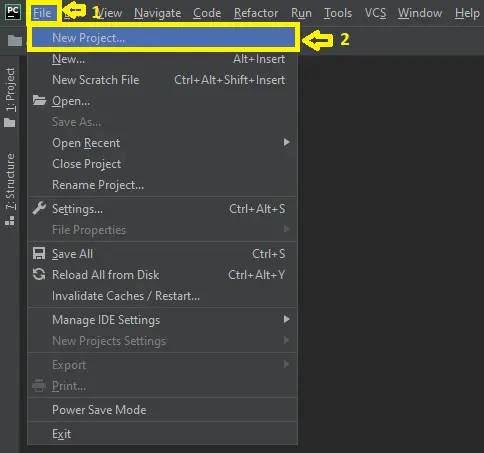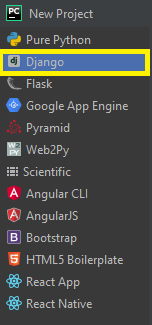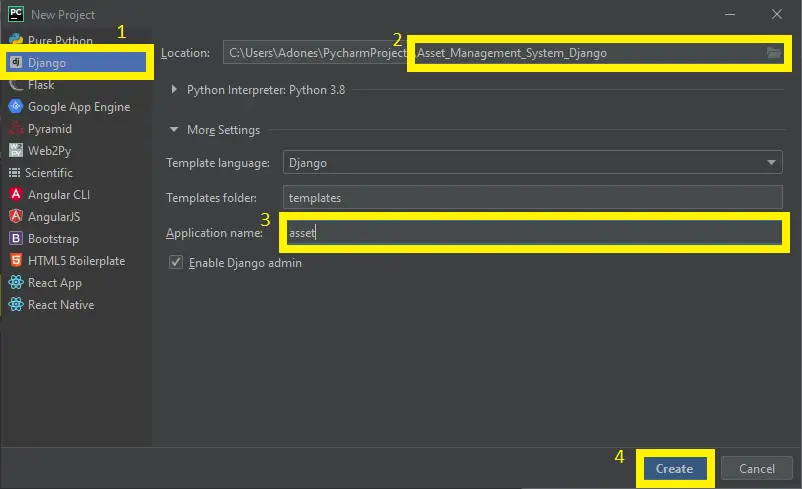Asset Management System Project in Django with Source Code
This Asset Management System Project in Django created based on python, Django, and SQLITE3 Database.
The asset system helps a firm administrator to see which employees have which assets by keeping track of the assets essential to their organizations’ day-to-day operations.
This application uses Pusher to deliver admin notifications when users log in, log out, or update their profiles.
An Asset Management System in Django is an easy project for beginners to learn how to build a web-based python Django project.
We will provide you with the complete source code and database for the python project so that you can easily install it on your machine and learn how to program in Python Django.
To start creating a Asset Management System Project in Python Django, makes sure that you have PyCharm Professional IDE Installed in your computer.
This Asset Management System in Django Framework, Also includes a Download Source Code for free, just find the downloadable source code below and click download now.
Admin Features: Asset Management System Project in Django
- Login Page – The page where the system administrator enters their system credentials in order to gain access to the system’s administrative side.
- New Asset Page -This is the page where an administrator can add a new asset.
- New Assign Asset – The page on which an administrator can assign new asset.
- Search Asset – The page on which an administrator can search asset.
- New User Page – The page where a new admin credentials are created by an admin.
- Users list – This is the page that lists and manages the added users.
| About Project | Project Details | Definition |
|---|---|---|
| Project Name | Asset Management System in Django | Asset management is a system that allows businesses to keep track of all of their assets, including cars, equipment, and investments. Keeping track of assets may assist expedite operations, especially when it comes to selling or disposing of them. |
| Python version (Recommended) | 3.8 Version | Python 3.8 introduces some new syntax to the language, as well as a few small modifications to existing behavior and, most importantly, a slew of performance improvements, following in the footsteps of the previous 3.7 version. |
| Programming Language Used | Python Django Language | Django is a high-level Python web framework for building safe and maintainable websites quickly. Django is a web framework built by experienced developers that takes care of a lot of the heavy lifting so you can focus on developing your app instead of reinventing the wheel. |
| Developer Name | itsourcecode.com | Free projects containing source code in Java, PHP, Python, Django, VB.Net, Visual Basic, C, C++, C#, Javascript, and other languages are available on this website. |
| IDE Tool (Recommended) | Sublime, Visual Studio, PyCharm | Sublime Text is a source code editor that is available for purchase. It comes with built-in support for a variety of programming and markup languages. Plugins, which are often community-built and maintained under free-software licenses, allow users to extend the functionality of the system. Sublime Text has a Python API to help with plugins. |
| Project Type | Web Application | A web application, unlike computer-based software programs that operate locally on the device’s operating system, is application software that runs on a web server. The user uses a web browser with an active network connection to access web apps. |
| Database | SQLite | SQLite is a programming language that is used to create embedded software for devices such as televisions, cell phones, and cameras. It can handle HTTP requests with low to medium traffic. SQLite has the ability to compress files into smaller bundles with less metadata. SQLite is a temporary dataset that is used within an application to process data. |
Asset Management System in Django Steps on How to Create a Project
Time needed: 5 minutes
Here are the steps on how to create a Asset Management System Project in Django with Source Code.
- Step 1: Open file.
First , open “pycharm professional” after that click “file” and click “new project”.

- Step 2: Choose Django.
Next, after click “new project“, choose “Django” and click.

- Step 3: Select file location.
Then, select a file location wherever you want.

- Step 4: Create application name.
After that, name your application.

- Step 5: Click create.
Lastly, finish creating project by clicking “create” button.

- Step 6: Start Coding.
Finally, we will now start adding functionality to our Django Framework by adding some functional codes.
Functionality and Codes of the Asset Management System Project in Django with Source Code
- Create template for the homepage in Asset Management System in Django.
In this section, we will learn on how create a templates for the homepage. To start with, add the following code in your base.html under the folder of /templates/.
{% load static %}
{% load bootstrap4 %}
<!DOCTYPE html>
<html>
<head>
<!-- Required meta tags -->
<meta charset="utf-8">
<meta name="viewport" content="width=device-width, initial-scale=1, shrink-to-fit=no">
<!-- Bootstrap CSS -->
<link rel="stylesheet" href="https://maxcdn.bootstrapcdn.com/bootstrap/4.0.0/css/bootstrap.min.css" integrity="sha384-Gn5384xqQ1aoWXA+058RXPxPg6fy4IWvTNh0E263XmFcJlSAwiGgFAW/dAiS6JXm" crossorigin="anonymous">
<link rel="stylesheet" type="text/css" href="{% static 'asset_app/main.css' %}">
{% if title %}
<title>Asset Management System- {{ title }}</title>
{% else %}
<title>Asset Management System</title>
{% endif %}
</head>
<body>
<header class="site-header">
<nav class="navbar navbar-expand-md navbar-dark bg-steel fixed-top" style="background-image: linear-gradient( 89.1deg, rgba(55,64,77,1) 0.7%, rgba(66,156,193,1) 88.4% );">
<div class="container">
<a class="navbar-brand mr-4" href="{% url 'assets_app_home' %}">Asset Management System</a>
<button class="navbar-toggler" type="button" data-toggle="collapse" data-target="#navbarToggle" aria-controls="navbarToggle" aria-expanded="false" aria-label="Toggle navigation">
<span class="navbar-toggler-icon"></span>
</button>
<div class="collapse navbar-collapse" id="navbarToggle">
<div class="navbar-nav mr-auto">
<a class="nav-item nav-link" href="{% url 'assets_app_home' %}">Home</a>
<a class="nav-item nav-link" href="{% url 'asset_app-about' %}">About</a>
</div>
<!-- Navbar Right Side -->
<div class="navbar-nav">
{% if user.is_authenticated %}
<a class="nav-item nav-link" href="{% url 'assets-create' %}">Add Asset</a>
<a class="nav-item nav-link" href="{% url 'assets-create' %}">Assign Asset</a>
<a class="nav-item nav-link" href="{% url 'assets-create' %}">Claim Asset</a>
<a class="nav-item nav-link" href="{% url 'profile' %}">Profile</a>
<div class="dropdown">
<button class="btn btn-outline-info dropdown-toggle" type="button" id="dropdownMenuButton" data-toggle="dropdown" aria-haspopup="true" aria-expanded="false" style="color: aliceblue;">
Search Assets
</button>
<div class="dropdown-menu" aria-labelledby="dropdownMenuButton">
<a class="dropdown-item" href="{%url 'assetssearch'%}">Assets</a>
</div>
</div>
<a class="nav-item nav-link" href="{% url 'logout' %}">Logout</a>
{% else %}
<a class="nav-item nav-link" href="{% url 'login' %}">Login</a>
<a class="nav-item nav-link" href="{% url 'register' %}">Register</a>
{% endif %}
</div>
</div>
</div>
</nav>
</header>
<main role="main" class="container">
<div class="row">
<div class="col-md-8">
{% if messages %}
{% for message in messages %}
<div class="alert alert-{{ message.tags }}">
{{ message }}
</div>
{% endfor %}
{% endif %}
{% block content %}{% endblock %}
</div>
{% if user.is_authenticated %}
<div class="col-md-4">
<div class="content-section" stye>
<h3>Asset Management System</h3>
<p class='text-muted'>About your Assets
<ul class="list-group">
<li class="list-group-item list-group-item-light"><a href="{% url 'assets_app_home' %}">Assets Updates</a></li>
<li class="list-group-item list-group-item-light">Announcements</li>
<li class="list-group-item list-group-item-light">Calendar of Events</li>
</ul>
</p>
</div>
</div>
{% endif %}
</div>
</main>
<!-- Optional JavaScript -->
<!-- jQuery first, then Popper.js, then Bootstrap JS -->
<script src="https://code.jquery.com/jquery-3.2.1.slim.min.js" integrity="sha384-KJ3o2DKtIkvYIK3UENzmM7KCkRr/rE9/Qpg6aAZGJwFDMVNA/GpGFF93hXpG5KkN" crossorigin="anonymous"></script>
<script src="https://cdnjs.cloudflare.com/ajax/libs/popper.js/1.12.9/umd/popper.min.js" integrity="sha384-ApNbgh9B+Y1QKtv3Rn7W3mgPxhU9K/ScQsAP7hUibX39j7fakFPskvXusvfa0b4Q" crossorigin="anonymous"></script>
<script src="https://maxcdn.bootstrapcdn.com/bootstrap/4.0.0/js/bootstrap.min.js" integrity="sha384-JZR6Spejh4U02d8jOt6vLEHfe/JQGiRRSQQxSfFWpi1MquVdAyjUar5+76PVCmYl" crossorigin="anonymous"></script>
</body>
</html>
- Create template for the login form in Asset Management System Project in Django.
In this section, we will learn on how create a templates for the login form. To start with, add the following code in your login.html under the folder of /templates/.
{% extends "asset_app/base.html" %}
{% load crispy_forms_tags %}
{% block content %}
<div class="content-section">
<form method="POST">
{% csrf_token %}
<fieldset class="form-group">
<legend class="border-bottom mb-4">Log In</legend>
{{ form|crispy }}
</fieldset>
<div class="form-group">
<button class="btn btn-outline-info" type="submit">Login</button>
</div>
</form>
<div class="border-top pt-3">
<small class="text-muted">
Need An Account? <a class="ml-2" href="{% url 'register' %}">Sign Up Now</a>
</small>
</div>
</div>
{% endblock content %}
- Create template for the profile form in Asset Management System Project in Django.
In this section, we will learn on how create a templates for the profile form. To start with, add the following code in your profile.html under the folder of /templates/.
{% extends "asset_app/base.html" %}
{% load crispy_forms_tags %}
{% block content %}
<div class="content-section">
<div class="media">
<img class="rounded-circle account-img" src="{{ user.profile.image.url }}">
<div class="media-body">
<h2 class="account-heading">{{ user.username }}</h2>
<p class="text-secondary">{{ user.email }}</p>
</div>
</div>
<form method="POST" enctype="multipart/form-data">
{% csrf_token %}
<fieldset class="form-group">
<legend class="border-bottom mb-4">Profile Info</legend>
{{ u_form|crispy }}
{{ p_form|crispy }}
</fieldset>
<div class="form-group">
<button class="btn btn-outline-info" type="submit">Update</button>
</div>
</form>
</div>
{% endblock content %}
Downloadable Source Code Below.
Anyway, if you want to level up your programming knowledge, especially python, try this new article I’ve made for you Best Python Projects with source code for Beginners.
But If you’re going to focus on web development using Django, you can download here from our list of Best Django Projects with source code based on real-world projects.
How To Run The Asset Management System Project in Django?
- Step 1: Extract/unzip the file
- Step 2: Go inside the project folder, open cmd and type the following commands to install Django Framework and run the webserver:
- pip install -r requirements.txt
- python manage.py migrate
- python manage.py runserver
- Step 3: Finally, open the browser and go to http://127.0.0.1:8000/
Summary
In summary, the Asset Management System Project in Django with Source Code can be useful to students or professional who wants to learn python programming language. This project can also be modified to fit your personal requirements.
Hope this project will help you to improve your skills. Happy Coding!
- How To Make A Point Of Sale System In Python
- Best Python Projects for Beginners
- Python MySQL Connection: Simple Python Step by Step Guide
- Python PIP Command Set-up / Fix: Step by Step Guide
- Random Password Generator in Python Projects With Source Code 2020
- Python Range Function|Range in Python Explained with Examples 2020
- School Management System Project In Django With Source Code
- Django Login And Registration With Source Code
- CRUD App In Django With Source Code
- Drag And Drop JavaScript With Source Code
- Todo List App Django With Source Code
Inquiries
If you have any questions or suggestions about Asset Management System Project in Django with Source Code, please feel free to leave a comment below.




